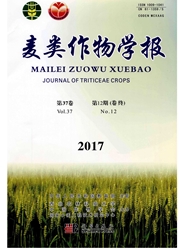

 中文摘要:
中文摘要:
2001至2002年分别在河北保定、江苏徐州和姜堰3个不同的生态点,研究了播期(适播和晚播)对小麦(徐州26、皖麦38和徐州25)籽粒戊聚糖含量的影响。结果表明:晚播能极显著提高小麦籽粒戊聚糖含量。在播期、环境与基因犁凼子中,以环境对籽粒戊聚糖含量的影响最大。保定点和姜堰点的小麦籽粒戊聚糖含量明显高于徐州点。播期与生态点间、生态点与品种间存在显著的互作效应。播期相同,环境对小麦籽粒戊聚糖含量的影响大于基因型。随着纬度的升高,播期对籽粒戊聚糖含量的影响下降。小麦籽粒戊聚糖含量与气象因子密切相关,以花后气象因子的效应大。
 英文摘要:
英文摘要:
Three wheat varieties of Xuzhou 26, Wanmai 38 and Xuzhou 25 were grown at three ecological sites in China as Baoding, Xuzhou and Jiangyan in 2001 to 2002. Two sowing dates as optimal and late sowing were designed at each site to study variation in pentosan content with sowing date and ecological environment. The results indicated that significant difference in pentosan contents was found between sowing date treatments, and pentosan content in wheat grains was significantly higher with late sowing as compared with optimal sowing treatment. The effect of ecological environment on pentosan content was higher than those of sowing date and variety. Significant differences in pentosan content were also found among different ecological environments, and the pentosan content in Baoding and Jiangyan was significantly higher than that in Xuzhou. Significant interactions between sowing date and ecological environment, and between ecological environment and genotype on pentosan content were observed. At the same sowing date, the effect of ecological environment on pentosan content was much higher than that of genotype, especially under optimal sowing date treatment. Effect of sowing date on pentosan content decreased with increasing latitude. Close relationship between pentosan content and weather conditions was observed, and weather factors after anthesis showed more important impact on pentosan content than those before anthesis.
 同期刊论文项目
同期刊论文项目
 同项目期刊论文
同项目期刊论文
 Starch granules size distribution in superior and inferior grains is related to changes in activitie
Starch granules size distribution in superior and inferior grains is related to changes in activitie Alterations in photosynthesis and antioxidant enzyme activity in winter wheat subjected to post-anth
Alterations in photosynthesis and antioxidant enzyme activity in winter wheat subjected to post-anth 期刊信息
期刊信息
